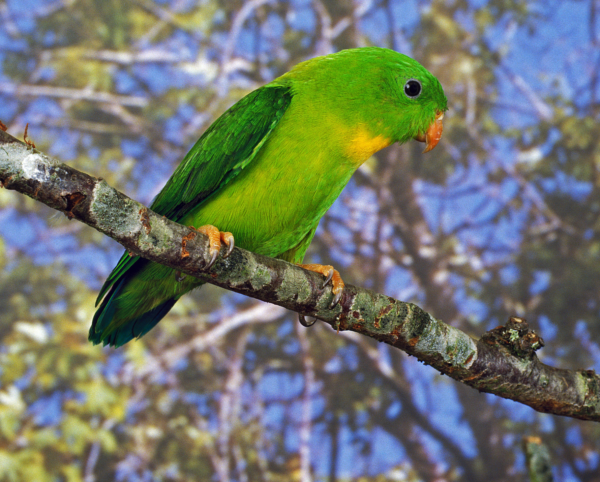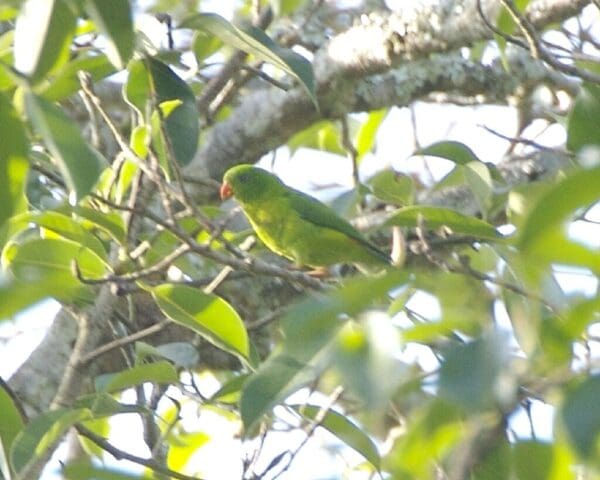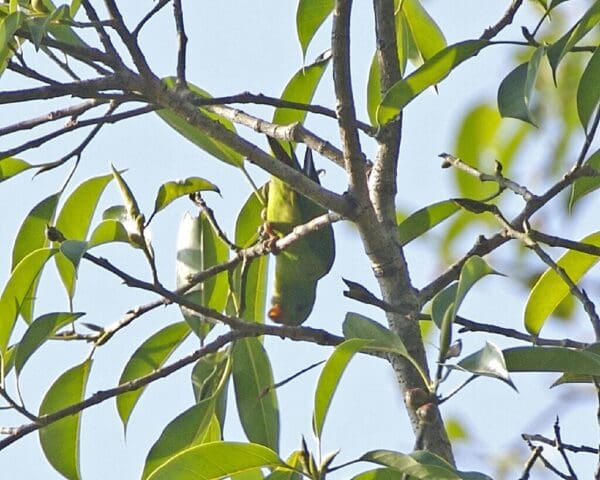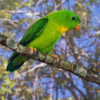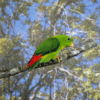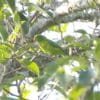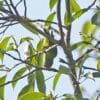Yellow-throated Hanging Parrot
Also known as:
Javan Hanging Parrot, Little Hanging Parrot
Also known as:
Javan Hanging Parrot, Little Hanging Parrot

Loriculus

pusillus
Size:
12 cm (4.7 in)
Weight:
Probably 25-30 g (0.9-1 oz).
Subspecies including nominate:
one
Colour Adult:
Both adults in general green; yellow tint to mantle; red rump and tail coverts; orange/yellow mark on throat, minimal in female. Beak orange. Eye yellow/white.
Colour Juvenile:
As in adult female but with little or no yellow on throat. Beak yellow/brown. Eye pale brown.
Call:
Calls made in flight are shrill and high-pitched. Also squeaky chattering while feeding.
Yellow-throated Hanging Parrot – AVoCet Cornell Lab Macaulay Library
More Information:
Content Sources:
CITES
BirdLife International
Cornell Lab of Ornithology/Birds of the World
A Guide to Parrots of the World, Juniper and Parr, 1998
Parrots of the World, Forshaw and Cooper, 1977.
Parrots of the World, Forshaw, 2006.
Lexicon of Parrots, Thomas Arndt.
Parrots in Aviculture, Low, 1992.
Parrots: Their Care and Breeding, Low, 1986.
Captive Status:
Rare
Longevity:
—
Housing:
Outdoor enclosure (in warm climates), minimum length 1.5 m (5 ft) with enclosed shelter, for 1-2 pairs.
Diet:
Fruits such as: apple, pear, mango, cut into halves; fruits in season like pomegranate, guavas, cactus fruits and berries such as blackberries and red currants; small seed mix such as: canary, millet and soaked oats; spray millet; sponge cake and nectar; insectivorous mixture, mealworms, well-cleaned maggots and ant pupae.
Enrichment:
Vigorous chewers, so provide bird-safe, unsprayed flowering, pine, fir, willow or elder branches; wooden and vegetable tanned leather toys (discard when dirty). Also enjoy bathing so provide overhead misters or shallow bowls of water.
Nest Box Size:
Vertical box 5″ x 5″ x 24″ (12.7 cm x 12.7 cm x 61 cm).
Clutch Size:
2
Fledging Age:
35 days
Hatch Weight:
—
Peak Weight:
—
Weaning Weight:
—
World Population:
Unknown, decreasing.
IUCN Red List Status:
Near Threatened
CITES Listing:
Appendix II
Threat Summary:
Not globally threatened. The population size is unknown, but the species is described as generally uncommon throughout its range. Forest loss in the Java and Bali lowlands has been extensive. However, the species’ tolerance of degraded habitats and to persist at higher elevations, where forest destruction has been less severe, means that its decline has been less rapid. Evidence for an increase in desirability for this species is presented by market data, which show a possible increase in demand from 2016 to 2017, broadly in line with an increase in cagebird ownership on Java over the past decade. This trajectory for the species is concerning, and accordingly the species is suspected to decline at a rate of 15–29% over the next three generations, thus approaching the thresholds for listing as threatened under criteria A3d+4d.
Range:
Java and Bali, Indonesia.
Habitat:
Found up to 1450 m (4756 ft) in forest, forest edge and swamp forest.
Wild Diet:
Feeds on nectar, fruit, figs, leaf buds and in flowering Erythrina trees, in Ficus, and at Cassia siamea flowers.
Ecology and Behaviour:
Probably nomadic in response to food availability. Seen in pairs, singly or in small groups, with larger gatherings at flowering trees. Very visible in flight, but difficult to spot while foraging in treetop foliage. Birds very active, fluttering rapidly from one tree to the next.
Clutch and Egg Size:
2 broad-oval eggs, 19.5 x 15.0 mm (0.8 x 0.6 in).
Breeding Season:
March-May; nest is in old barbet cavity or palm trunk.
Related Links:
—
